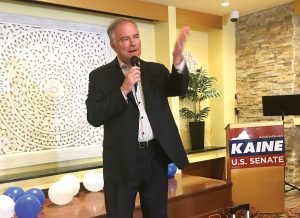
Editor’s Note — Prominent former senior archivist at the Library of Congress and long time Falls Church resident and civic activist Brad Gernand, who has co-authored three books on Falls Church history, the most recent in 2000 as part of the 300th anniversary of Anglo settlements at the Little City’s location, is the author of this seminal review of Charlie Clark’s new book, “The Life and Times of the Falls Church News-Press,” out this month from the History Press and available at One More Page Books in N. Arlington, Amazon and other locations.
Communities don’t just happen. They are built and maintained. Falls Church’s is arguably one of the most cohesive and coherent in the country. Part of this is due to its tiny size and population. And part of it is due to its highly informed residents.
There again, highly informed citizens don’t just happen — they are provided information of use and value about their communities. In large swaths of the United States this is no longer happening. Newspapers and local journalism seem to be at death’s door. Not so in Falls Church, and now we have a look at why.
A new book, “Life and Times of the Falls Church News Press,” by veteran newspaperman Charlie Clark, provides a clear-eyed look at the founding and evolution of the Falls Church News-Press. What is clear in Clark’s account is the extent to which the history of the newspaper has paralleled the history of the city during the past three decades. This is no accident, Clark concludes.
I clearly remember the afternoon of March 28, 1991. I came home from work to find a free newspaper lying at the foot of my driveway. It was obvious from its first edition that the News-Press and its publisher, Nick Benton, fully subscribed to Daniel Burnham’s famous maxim: Make no small plans.
I had moved to the City a few months prior and was having trouble fathoming what made Falls Church tick, as there was no source of local news. Was there a common theme, and did the community have a vision?
Yes, and Benton and his new newspaper helped mold and shape that vision, Clark reports. It also helped establish, define and provide Falls Church a sense of identity and place.
Falls Church has experienced three major phases of build-out and development: following the Civil War, following World War II, and — most recently — the past 10 or 15 years.
Throughout the history of American journalism, newspapers have been boosters of their local communities. Sometimes this meant stressing positive news at the expense of negative. And it always has meant “booming” (to use the old-fashioned word) the city’s economic prospects.
Clark finds the Falls Church News-Press has done so consistently, and says the City came to embrace Benton’s recipe for growth and prosperity: an assertive wooing of business, with a view to expanding the City’s tax base. This is to some degree a matter of conjecture: the free market has dictated Falls Church’s rapid growth, and it would likely have occurred with or without Benton.
Benton, however, was instrumental in crystallizing viewpoints, both pro and con. In the early 1990s he endorsed the “Greensleeves” proposal by the Village Preservation and Improvement Society to rebuild West Broad Street, planting trees, installing matching street furniture and bricking the sidewalks. He said the charm offensive would signal that Falls Church was open for business. And signal it did.
It was not long — in economic development terms — before Benton was promoting another key concept: using or repurposing land more effectively. As Clark notes, this has been his clarion call almost from day one. At one point he challenged the City to pull together disparate parcels on all sides of Don Beyer Volvo to create one large site and build the tallest office tower in Northern Virginia.
Many Falls Church residents scoffed. But then, building the region’s tallest tower wasn’t necessarily what Benton was after, was it? It was all about the underlying philosophy, Clark writes.
Far from authoring a “puff piece,” Clark appears to have left no stone unturned. He seems to have read every issue of the News-Press published since 1991, charting trends, changes, and personalities.
The biggest personality, of course, is Benton. In many respects a classic newspaperman — presenting a rumpled appearance, a willingness to slaughter sacred cows, and a big heart hidden behind a gruff exterior — Benton has been the star of the show. His unrelenting work ethic and long hours in the office across 33 long years are reflected in every issue of the paper, Clark reports.
Clark is at his best when he tells us things we never knew. Clark’s account of producing that first edition of March 28, 1991, is both interesting and informational, with small details (the staff rode in a Mustang convertible to the printer in Gaithersburg, after working all night on March 27) adding color.
A stray detail from that moment could easily have been a subtitle for Clark’s book, and serves as a prediction — even though tongue in cheek — of the next 33 years. As the first edition rolled off the conveyor belt, Benton, partly in jest, stood on a box and proclaimed, “Let every tyrant tremble!”
Although tyrants were in short supply, Benton got right to work with the second edition. The newspaper he launched has been “old school” in many respects, up to and including its continuing survival and prosperity. Clark gives the impression that Benton feels more comfortable with tried and true ways of publishing newspapers, and has left it to his staff to suggest using new technologies.
Certainly, the newspaper’s website reflects this. In an age in which online presentation of news is the key driver, Benton’s paper remains almost a stridently print-based product, with no mobile app and with its online version merely serving as archive. And somehow it all works.
Clark’s book was clearly a labor of love, or at least deep interest. It makes an excellent first impression with its use of old-style newspaper font for its title (the interior font is more workmanlike). His scorched-earth-style research is clearly a strength. And his frequent use of interviews with knowledgeable people, some of whom give “warts and all” accounts from across the years, is a plus.
One such source, Dave Eckert, hasn’t lived in the Little City for years, but describes the early, heady days of the newspaper as well as the beginnings, which were not entirely evident at the time, of Falls Church’s transition from “urban village” to “little city”. Clark’s inclusion of Eckert — and others — as useful contributors to the tale strengthens the book.
Clocking in at just shy of 200 pages, Clark’s book navigates the years carefully and concisely. This reviewer finds only one thing missing: a lack of discussion — perhaps stemming from Benton’s reporting over the years — that the new, improved Falls Church is in key respects harder to live in than the community which preceded it. With the growth came significant downsides.
The new Falls Church feels like a pressure cooker, choked with traffic and ever more congested. These viewpoints—the stuff of many conversations between neighbors — were generally only reflected in letters to the editor, not in Benton’s reporting. Did he let his interest in business growth color or slant his newspaper’s take on it? Clark doesn’t say.
Perhaps, in the final analysis, it may be said, with only a bit of hyperbole, that — love it or loathe it — we’re now living in the city that Nick Benton helped build.












